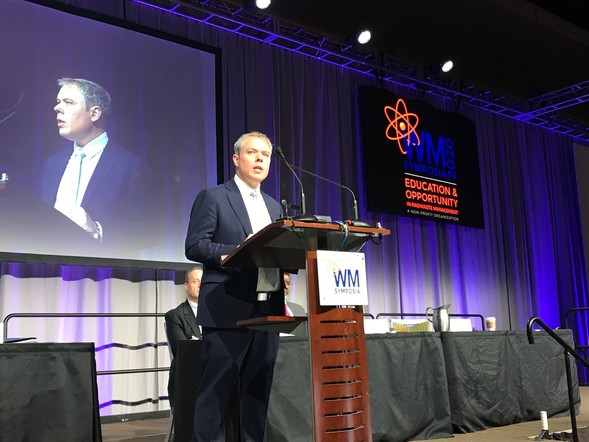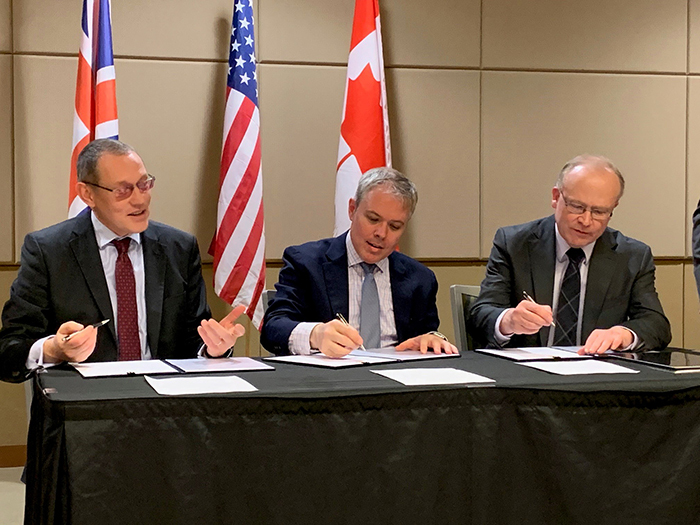|
EM and its counterparts in Canada and the United Kingdom formalized a trilateral agreement to strengthen collaborations on the cleanup of legacy nuclear sites. From left, Adrian Simper of the Nuclear Decommissioning Authority of the United Kingdom; Ike White representing EM; and Alastair MacDonald of Atomic Energy of Canada Limited, took part in a signing ceremony at the Waste Management Symposia 2020 in Phoenix.
PHOENIX – A three-party agreement signed by EM and its counterparts in Canada and the United Kingdom aims to strengthen their collaborations on cleaning up legacy nuclear sites.
EM senior advisor William “Ike” White formalized the trilateral agreement, along with Alastair MacDonald, vice president of decommissioning and waste management oversight for Atomic Energy of Canada Limited (AECL), and Adrian Simper, group director for strategy and technology for the Nuclear Decommissioning Authority of the United Kingdom (NDA).
The signing took place Sunday at a ceremony held at the Waste Management Symposia 2020 in Phoenix.
The Department of Energy, NDA and AECL have entered into bilateral arrangements with each other to share lessons learned in developing and applying technologies and approaches to legacy radioactive waste management.
The new agreement solidifies the existing relationships and enables three-way cooperation in areas of mutual interest including aging infrastructure management, in situ decommissioning/ disposal and near surface disposal facilities -- all of which are important considerations across the three countries in working towards safe and effective cleanup of legacy sites.
“Collaborating with our counterparts and sharing best practices wherever possible will help to ensure that we all learn from one another,” said White, senior advisor to the Under Secretary of Science overseeing the Office of Environmental Management.
“The ability to conduct joint technology projects, exchange personnel and conduct inter-country program reviews will increase the capabilities of our people, and allow all of us to leverage our collective resources as we tackle some of the most difficult environmental challenges,” he said.
The agreement has a formal structure to ensure that activities are targeted on areas that promise the most benefit in terms of safe, efficient and timely environmental remediation, and that the proposed efforts have support from the highest levels.
“We are all working hard, but face challenges cleaning up our sites and effectively managing our waste, to better protect the environment and the health and safety of our communities, all the while ensuring good value,” said Richard Sexton, AECL president and chief executive officer. Sexton added the agreement “clearly signals that through shared knowledge and best practices, we can build on experience gained by our counterparts and tap into the right expertise, to find unique and safe solutions to common issues, thereby leaving a better legacy for future generations.”
“We have been collaborating on a bilateral basis for some years now with our North American friends,” Simper said. “This has allowed us each to benefit from sharing each other’s experiences of our most difficult clean-up tasks. Coming together under this agreement is a natural progression and provides a unique opportunity to accelerate our individual missions and better manager our environmental responsibilities.”
 |
|
A wall crawler inserts an inspection sensor into a small air slot under the inner shell of a Hanford double-shell tank. In this waste storage tank, operators surveyed six air slots to obtain tank-bottom thickness readings at multiple locations. |
RICHLAND, Wash. – EM’s Office of River Protection and tank operations contractor Washington River Protection Solutions recently used an innovative robotic system that employs ultrasonic sound waves to help engineers detect and mitigate corrosion of Hanford Site waste storage tanks.
The system features a small, remotely operated “crawler” that fits in air channels about the width of a cell phone underneath the inner shell of double-shell storage tanks. The system sends out ultrasonic sound waves to detect flaws in the tank’s carbon steel and gives engineers a look at spaces that haven’t been seen in decades.
“The achievement is monumental in that it allows periodic and reliable thickness measurements of the bottom of the inner tanks,” said Dustin Stewart, a program manager for DOE’s Tank Farms division. “Knowing the condition of the tanks is essential to our mission of safely storing waste and providing waste for treatment.”
While the contractor has long used ultrasonic testing to examine the walls of double-shell tanks, the ability to access the bottom of a primary tank has been a significant challenge, because the primary tank rests on an insulating pad within the secondary tank liner.
To perform the test, the project team used a first-of-a-kind system that features a crawler to insert the testing sensor into air slots beneath the tanks. The wedge-shaped air slots are challenging to deploy the sensors into because they are only 2 ½ inches wide at the top, 1 inch wide at the bottom and 2 ½ inches high.
“The technology used here is based on proven systems used in industry,” said Washington River Protection Solutions engineer Jason Gunter. “We’ve become experts in adapting those systems to enable access and inspection in unique and challenging areas.”
Stewart said DOE is committed to developing and implementing new technologies that advance the Hanford cleanup mission and reduce the risk to the Columbia River that runs through the site in southeastern Washington State.
-Contributor: Mark McKenna
 |
|
Ceramic filters before and after testing. Based on extended pilot plant testing, research has shown that the formation of a "filter cake" on the ceramic filters, as shown below, is necessary to prevent plugging and provide for greater operating efficiency. |
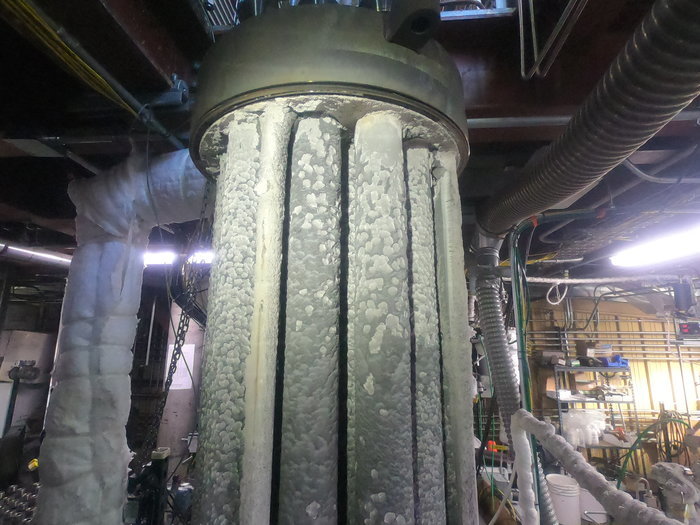
IDAHO FALLS, Idaho – New filters proposed for a key waste treatment facility at the Idaho National Laboratory site underwent extensive testing recently and will be installed at the facility in the coming months, an important step towards beginning operations later this year.
Hazen Research, an industrial laboratory in Golden, Colorado completed a 1,262-hour demonstration to test the effectiveness of ceramic filters at removing fine solids at a pilot plant that was designed to replicate the steam-reforming processes planned for use at the Integrated Waste Treatment Unit (IWTU).
“The ceramic filters showed real promise when we were analyzing a host of filter media,” said Fluor Idaho Chief Engineer Joe Giebel. “The long-term demonstration of ceramic filters at Hazen have proven that the media can perform effectively at the high temperatures that are present in the process gas filters at the IWTU.”
Hazen used the same waste simulant that the IWTU has used in six prior demonstration runs where more than 225,000 gallons were converted to a granular solid. The previous filters used at IWTU were constructed of a metal matrix that became plugged during several of the previous demonstration runs, reducing filter efficiency.
Ceramic filters are used throughout industry due to their ability to withstand high heat and corrosive environments. Once the ceramic filters are installed at IWTU, the facility will prepare for a confirmatory run that will test them for a number of weeks.
Construction of the IWTU was completed in 2012. Several equipment and chemistry issues have kept the facility from beginning treatment of 900,00 gallons of liquid radioactive waste from three underground storage tanks at the Idaho Nuclear Technology and Engineering Center. The waste was generated during later phases of spent nuclear fuel reprocessing, which ended at INTEC in 1992.
Engineers from DOE contractor Fluor Idaho and other fluidized bed technology experts have resolved all prior equipment and chemistry challenges at the IWTU. Once the facility completes a confirmatory run using the ceramic filters, engineers and operators will prepare IWTU for actual liquid waste treatment expected late this year.
-Contributor: Erik Simpson
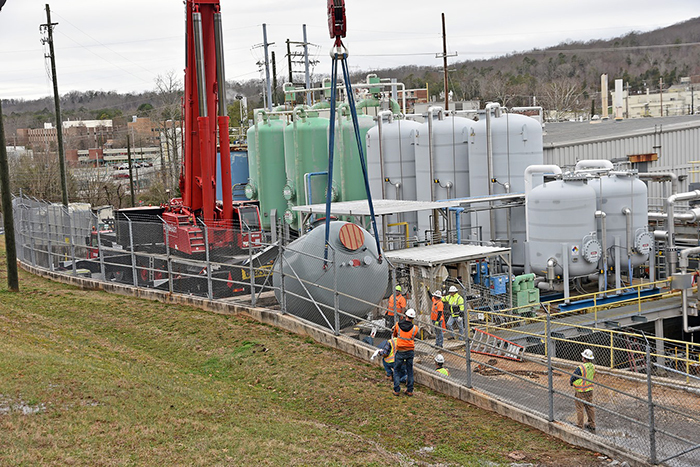 A crane lowers one of the five new vessels for a new modernized zeolite treatment system at Building 3608 in Oak Ridge National Laboratory’s central campus area. It replaces an aging system in Building 3544.
OAK RIDGE, Tenn. – EM workers are making progress upgrading aging radiological wastewater treatment infrastructure essential to Oak Ridge National Laboratory (ORNL) operations.
They are installing a new zeolite treatment system, which is designed to remove cesium and strontium from wastewater.
Installation of that system is the latest modernization effort funded by a $17 million EM investment over the past two years to extend the life of the Liquid and Gaseous Waste Operations infrastructure. Crews have replaced deteriorated piping, antiquated equipment, and failing electrical systems.
The infrastructure consists of numerous interconnected facilities that support crucial waste treatment activities for EM and DOE’s Office of Science. Due to its age and deteriorated condition, Building 3544 presented one of the largest risks to the Liquid and Gaseous Waste Operations. For more than four decades the building had served as a radiological wastewater treatment facility, housing the previous zeolite treatment system.
EM investigated several alternatives before choosing to install a modernized zeolite treatment system at Building 3608, which formerly served as a non-radiological wastewater treatment facility.
“Moving the treatment system to a new facility and modernizing the equipment allows us to continue effectively treating wastewater in a safe, cost-effective manner,” said Nathan Felosi, EM ORNL portfolio federal project director. “EM’s work to upgrade essential infrastructure and address excess contaminated facilities is protecting and enabling ORNL’s current and future research missions.”
Oak Ridge Office of Environmental Management cleanup contractor UCOR is installing the new treatment system. It includes five vessels — two dual media filters and three zeolite columns — and dewatering equipment. The vessels were assembled and tested by the manufacturer prior to being transported to the facility.
UCOR is scheduled to conduct startup testing on the new treatment system this spring, after new equipment is operational. Following testing, Building 3544 will go into standby status for up to a year, serving as a backup for the new treatment system at Building 3608.
-Contributor: Susanne Dupes
 Workers with Hanford contractor CH2M HILL Plateau Remediation Company test a robotic crawler on the roof of a former fuel storage bunker. The crawler was used to safely evaluate the load capacity of the roof as part of preparations for future demolition activities.
RICHLAND, Wash. – Workers recently sent a robotic crawler on an advance scouting mission to ensure the safety of crews preparing an aging structure near the Hanford Site’s K West Reactor for demolition.
EM contractor CH2M HILL Plateau Remediation Company (CHPRC) deployed the remotely operated device – which weighs about 1,000 pounds – to verify the structural integrity of the roof of a former storage bunker for fuel oil. Workers will need to walk across the roof to evaluate the contents of tanks in the bunker and prepare for other demolition activities.
“Worker safety is always our top priority,” said Mark French, federal project director at EM’s Richland Operations Office. “This remotely operated crawler gives workers the confidence the roof will hold them and their equipment as they do their work to prepare to demolish this bunker.”
During Hanford Site operations, the bunker stored nearly 2 million gallons of fuel oil to support a powerhouse that supplied cooling water to the K West Reactor. Preparations will continue through 2020, with demolition of the storage bunker expected to begin next year. The work is part of ongoing efforts to reduce risk to the nearby Columbia River.
“The crawler plays a key role in increasing the safety of this project,” said Jim Rush, deputy vice president for CHPRC’s K Basin Operations. “The versatility of this device may also provide opportunities for its use on other Hanford cleanup projects.”
-Contributor: Rochelle Juette
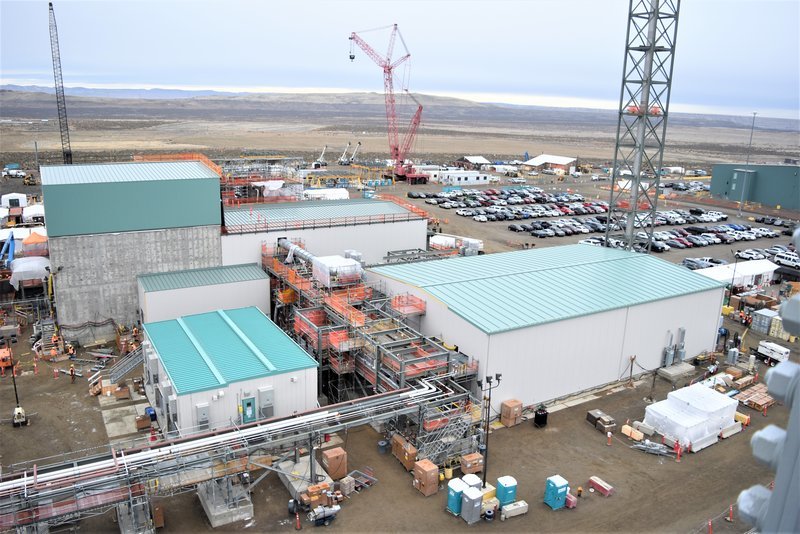 RICHLAND, Wash. – Crews at Hanford Site's Waste Treatment and Immobilization Plant recently completed construction and startup at the Effluent Management Facility electrical powerhouse building (pictured at front, left). The building has been handed over to the waste treatment plant commissioning team to ensure the systems are integrated, validated and ready to support future plant operations. The powerhouse contains transformers, motor control centers, and more than 11,000 feet of electrical cable. The 13.8-kilovolt powerhouse will provide electricity to facility systems and processing equipment. In the meantime, remaining effluent facility work continues as the last major waste treatment plant construction project to support Direct-Feed Low-Activity Waste operations.
-Contributor: Greg Atencio
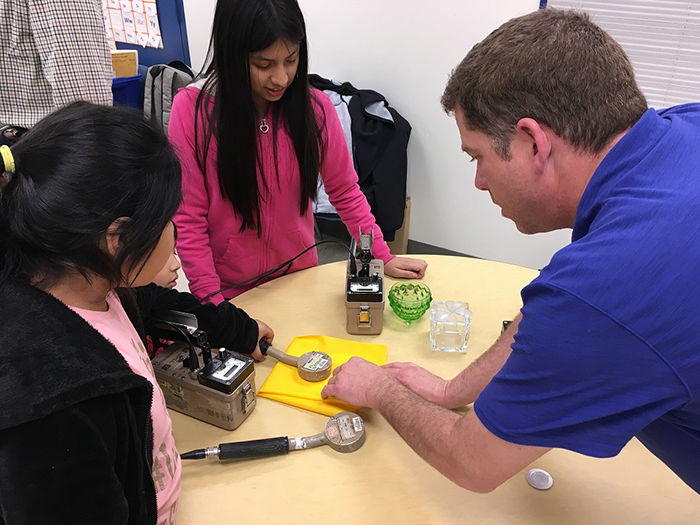 Mike Franklin, a field radiological engineer with UCOR, shows students how to use instrumentation to survey and detect radiation at the STEM event at Jefferson Middle School in Oak Ridge.
OAK RIDGE, Tenn. – Oak Ridge’s EM program and two of its contractors, UCOR and Isotek, recently supported a local middle school’s science, technology, engineering, and mathematics (STEM) night, which attracted 700 students and their families.
The event at Jefferson Middle School offered participants a unique opportunity to learn about the wide variety of careers in STEM fields required to perform EM projects while getting hands-on demonstrations with special equipment. It was the second-annual STEM night.
With numerous local community partners pitching in at the event, attendees did everything from race carbon dioxide-powered cars, fly drones, compete with robots, print using 3-D technology, and separate isotopes of chemical elements.
“The best part about all of this is seeing families come together and experience STEM as a family,” Jefferson Middle School STEM Coach Callie Painter said.
Isotek’s interactive booth allowed participants to learn how one of the company’s current EM projects is separating isotopes and creating material for next-generation cancer research and treatment.
“The hands-on activity made it very interesting. I didn’t realize how complex nuclear can be, so it made me want to get more involved,” said Olivia, an eighth-grader attending the event who expressed interest in becoming a pediatrician. “This is really cool how it helps people with cancer in a different way.”
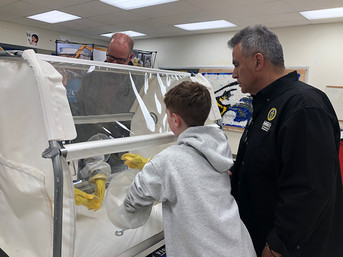 |
|
James Nunz, project management branch chief for Oak Ridge’s EM program, teaches students how to use a glovebox during a demonstration at the STEM event. |
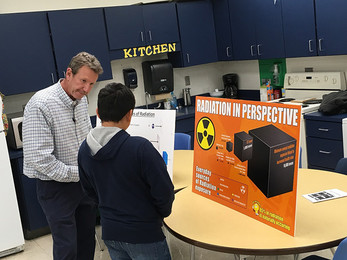 |
|
Joe Biggerstaff, a radiological protection integration and technical manager with UCOR, provides information about the sources of radiation to an attendee at the STEM event. |
Volunteers from EM and UCOR hosted a “Radiation in Perspective” learning session, where students learned about naturally occurring radiation, different sources of radiation, and how workers are protected against radiation when they conduct major environmental cleanup projects. The students also wore personal protective equipment, performed activities in a glovebox, and used equipment to survey pretend radiation materials.
Among the volunteers were nuclear material control and accountability assistant managers, data managers, fire protection engineers, mechanical engineers, maintenance coordinators, radiological protection integration managers, field radiological protection managers, field radiological engineers, and environmental scientists.
UCOR is EM’s Oak Ridge cleanup contractor, and Isotek supports EM’s highest priority project at DOE’s Oak Ridge National Laboratory: to eliminate the nation’s uranium-233 inventory.
-Contributors: John Gray, Shannon Potter
 Norbert Doyle, EM Deputy Assistant Secretary for Acquisition & Program Management discusses EM’s mission and major contracting opportunities during the “Federal Contract Opportunities Forecast” session at Reservation Economic Summit 2020.
LAS VEGAS – EM officials engaged with representatives of tribal owned businesses during the recent Reservation Economic Summit 2020 to discuss how they can help the cleanup program accelerate work completion.
The federal officials met one-on-one with Indian Country businesses during the event, which brings together tribal leaders, members of Congress, federal agency representatives, state and local officials, and CEOs. The event is sponsored by the National Center for American Indian Enterprise Development (NCAIED), which marks its 51st anniversary this year.
EM’s participation focused on how tribal owned businesses and Alaska Native corporations can support the EM end-state contracting initiative to accelerate cleanup work at sites.
Norbert Doyle, EM Deputy Assistant Secretary for Acquisition & Project Management, highlighted strategic subcontracting as the “sweet spot” — a way to enhance opportunities for small businesses — and stressed the importance of pre-solicitation and pre-proposal conferences.
Doyle noted the importance of EM’s collaborations with Indian Country, as several of EM’s cleanup sites are located near sovereign tribal nations and impact Indian lands and resources. He also highlighted potential contracting opportunities for Indian Country businesses.
During a panel session, Doyle emphasized the role of American Indian tribes in EM’s renewed focus on completing cleanup across the DOE complex. “It continues to be both important and rewarding to participate at RES, especially in the federal contracting panel discussion and ‘matchmaking’ with tribal firms - firms that have unique capabilities to both support the DOE-EM mission and benefit Indian Country,” he said.
 |
|
From left to right: Norbert Doyle, EM Deputy Assistant Secretary for Acquisition & Program Management; Anne Marie Bird, EM Small Business Program Manager; Chris James, President & CEO National Center for American Indian Enterprise Development; Albert Petrasek, EM Tribal Affairs Director; Demitrous Blount, EM Program Analyst participate in Reservation Economic Summit 2020. |
EM and DOE officials participated in RES 2020 sessions that focused on contracting and procurement and federal contracting opportunities. Additionally, EM officials provided information about doing business with DOE to tribal business owners at the Procurement Matchmaking Expo and a booth at the Business Trade Show. Representatives from multiple DOE offices including Indian Energy Policy and Programs, Small and Disadvantaged Business Utilization, Economic Impact and Diversity, Loan Programs, and Fossil Energy supported the event.
-Contributors: Albert Petrasek, Demitrous Blount
|


